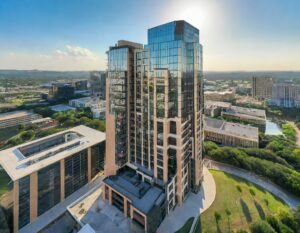Page Contents
- Market Overview
- Drastic Rent Growth Shift
- Historical Perspective
- Impact on High-End Properties
- Downtown Austin’s Challenges
- Submarket Variations
- Growing Oversupply and Vacancies
- Leasing Challenges Amidst Economic Conditions
- Suburban Vacancy Trends
- Vacancy Rates in High-Quality Assets
- Robust Leasing in High-Quality Properties
- Unprecedented Construction Levels
- Driving Forces Behind Construction Boom
- Current Challenges and Optimism
- Focus on Northern Austin
- Shift to Mid-Rise Construction
- Large-Scale Developments and High-End Focus
- Investment Sales Slowdown
- Decline in Sales Volume
- Characteristics of Recent Sales
- HACA’s Active Role in the Market
- Observations on Property Prices
- Banking Sector’s Impact on Lending
- Closing Thoughts
Market Overview
- Austin’s apartment demand has recovered since late 2022, but new completions are overshadowing this growth.
- A record 18,000 new units will outpace the 13,700 units of annual net absorption, causing market imbalance.
- Despite lower demand in late 2022, annual net absorption reached 10,000 units, above the pre-pandemic average.
- Austin’s suburbs, like Williamson and Hays County, are growing due to affordability and amenities, boosting overall demand.
- In response to 2.7% population growth, Austin has 42,000 units under construction, but high costs are slowing starts.
- The construction of 28,000 high-end units worsens the supply-demand imbalance, increasing vacancies to 10.1%.
- Austin’s rent growth is now the lowest among top U.S. markets at -3.3%, with average rents remaining high at $1,660/month.
- Investment activity in Austin has significantly decreased, with the lowest unit sales since 2009 indicating market uncertainty.
- Mid-size suburban properties have seen an 8% price decline, with further decreases expected until market stabilization.
Drastic Rent Growth Shift
After peaking at 17.5% in 21Q4, Austin’s average asking rents are now at a -3.4% rate noted by CoStar. This marks the first negative change since 20Q4. The city’s decline in rent growth mirrors Phoenix, Las Vegas, and Orange County trends.
Historical Perspective
 Historically, from 2015 to 2019, Austin’s rent growth averaged 3.1% annually. Post-pandemic, the five-year average rose to 4.7%, surpassing the national average of 4%. A surge in domestic migration fueled this increase.
Historically, from 2015 to 2019, Austin’s rent growth averaged 3.1% annually. Post-pandemic, the five-year average rose to 4.7%, surpassing the national average of 4%. A surge in domestic migration fueled this increase.
Impact on High-End Properties
Owners of 4 & 5 Star properties, dominant in Austin, face tough competition. This has resulted in a -4.2% annual rent growth for these properties. In contrast, 3 Star properties see a 2.4% growth due to rising mid-range apartment demand.
Downtown Austin’s Challenges
Downtown Austin, especially vulnerable to rent deceleration, is adding numerous high-rise developments. With 55% of its inventory underway, it has the highest asking rents in Texas, leading to a 6.6% average rent reduction over the past year.
Submarket Variations
While most Austin submarkets are facing flat rents due to increasing supply, San Marcos shows potential. It offers one of the lowest average rents for high-end properties at $1,460/month, with a projected 2% growth in 24Q2.
Growing Oversupply and Vacancies
Austin’s market faces an oversupply, with vacancies rising from 7.5% in 22Q1 to 10.3%. The expected 18,300 unit deliveries in 2023 will be an all-time high. A potential 4,600-unit surplus is anticipated by year-end, exacerbated by economic uncertainties and inflation.
Leasing Challenges Amidst Economic Conditions
Leasing activity is slowing due to the uncertain economy and inflation’s impact on wages. New stock and cooling demand will likely push vacancies up. However, domestic migration and single-family home prices, up 35% in two years, still drive leasing.
Suburban Vacancy Trends
Vacancies in developing suburbs like Georgetown-Leander and Buda-Kyle are rising. These areas have high annual net deliveries relative to their size. Consequently, they are experiencing some of the highest vacancy rates in Austin.
Vacancy Rates in High-Quality Assets
 Austin’s 4 & 5 Star assets, 60% of the inventory, face increasing vacancy rates. The current 9.8% rate underperforms the national average of 9.2%. 3-star properties are also struggling with an 11.1% vacancy rate.
Austin’s 4 & 5 Star assets, 60% of the inventory, face increasing vacancy rates. The current 9.8% rate underperforms the national average of 9.2%. 3-star properties are also struggling with an 11.1% vacancy rate.
Robust Leasing in High-Quality Properties
Leasing has been strong among 4 & 5 Star assets, with a 4.5% net absorption rate. These properties offer rents 15% lower than the national average. Their affordability attracts renters, especially compared to other Sun Belt markets.
Unprecedented Construction Levels
Austin’s apartment construction remains at historic highs, with 42,000 units underway. This number surpasses the 2017-2019 quarterly average by three times. Austin ranks third nationally for units under construction as a percentage of inventory.
Driving Forces Behind Construction Boom
Austin’s status as a tech hub with substantial job and population growth has attracted a skilled labor force. Favorable financing in past years, including flexible lending and lower costs, spurred construction starts. These factors combined to motivate developers to initiate new projects.
Current Challenges and Optimism
Despite supply surplus and rising costs, construction starts have decreased by 50% quarter-over-quarter from 23Q1. Developers, however, remain optimistic about Austin’s long-term market potential. They see current projects as strategic positioning for an anticipated economic rally in 2024-2025.
Focus on Northern Austin
Georgetown-Leander, in Austin’s north, is experiencing rapid transformation and growth. Boasting 4,600 units underway, it’s known for its schools, affordability, and employment opportunities. North Austin, too, is booming, especially around the Domain area.
Shift to Mid-Rise Construction
Mid-rise units now represent 45% of all construction, a shift from the predominantly garden-style properties. These mid-rise buildings are primarily in Austin’s urban core, offering greater density and integration into existing residential communities. Meanwhile, the garden style remains popular in suburban areas.
Large-Scale Developments and High-End Focus
Developers focus on large-scale projects, with 85% of construction being part of projects with 250 or more units. High-quality, 4 & 5 Star units make up 67% of these developments, concentrated in Downtown, North Austin, and Georgetown-Leander. This strategy targets diverse renter needs, from downtown luxury to affordable suburban living.
Investment Sales Slowdown
In 23Q2, investment sales nearly halted due to higher borrowing costs and strict lending standards. The gap between buyer offers and seller expectations widened, further stalling sales. Consequently, owners are surprised by lower-than-expected offers.
Decline in Sales Volume
Sales volume in 23Q2 plummeted to 1,800 units, a 70% drop from the 2015-2019 quarterly average. Austin’s turnover rate now stands at 0.7%, ranking 19th among the largest U.S. markets. However, it underperforms compared to Dallas-Fort Worth, Houston, and San Antonio.
Characteristics of Recent Sales
Recent sales primarily involved larger properties of over 200 units. These transactions spanned various submarkets, including South Austin and Midtown Austin. Larger properties have dominated the limited transaction activity this quarter.
HACA’s Active Role in the Market
The Housing Authority of the City of Austin (HACA) has emerged as a key buyer, acquiring 1,300 units in the past 12 months. HACA focuses on preserving affordable housing, less impacted by rising interest rates. Their acquisitions aim to maintain affordability in high-demand areas.
Observations on Property Prices
Recent sales indicate declining property prices. For example, a North Austin 4-Star property sold for significantly less in 2022 compared to 2021. The market has yet to record any recent sales of 4 & 5 Star properties, reflecting its decreased sales volume.
Banking Sector’s Impact on Lending
Recent banking sector turmoil has led to stricter lending practices. Lenders are prioritizing liquidity, adopting a more conservative approach. This shift contributes to the already challenging investment climate in Austin’s real estate market.
Closing Thoughts
In conclusion, Austin’s real estate landscape is undergoing significant changes, marked by rising vacancies, shifting investment patterns, and evolving market dynamics. Understanding these trends is crucial for anyone looking to navigate this complex and rapidly changing market. For personalized insights and expert guidance tailored to your specific needs, contact Lumicre. Our team of seasoned professionals dedicates their expertise to helping you make informed decisions and succeed in Austin’s multi-family real estate market.